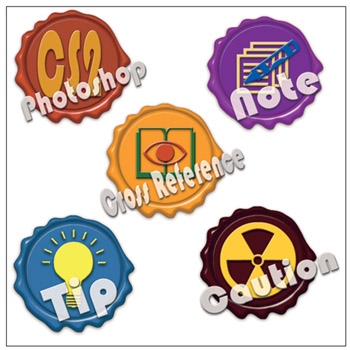Conventions
After boasting about how different this book is, here's a section that has remained pretty much the same since the old days. Fortunately, that's a good thing: even while content improves , conventions remain unchanged. After all, no sense messing with a good thing. For those of you who are new to the Bible, the following sections explain how things work.
Vocabulary
Although we try to conform to the rules of conversational English, we can't explain Photoshop in graphic and gruesome detail without occasionally reverting to the specialized language of the trade. Hence, the occasional technobabble. To help you keep up, we've italicized vocabulary words (as in anti-aliasing ) with which you may not be familiar, or which we use in an unusual context. An italicized term is followed by a definition.
If you come across a strange word that is not italicized (that bit of italics was for emphasis), look it up in the index to find the first reference to the word in the book.
Commands and options
To distinguish the literal names of commands, dialog boxes, buttons , and so on, I capitalize the first letter in each word (for example, click the Cancel button ). The only exceptions are option names, which can be six or seven words long and filled with prepositions ( to and of ) and articles ( a and the ). Traditionally, such words are not capitalized and this book follows that time-honored rule.
When discussing menus and commands, we use an arrow symbol to indicate hierarchy. For example, File Browse indicates the Browse command from the File menu. If you have to display a submenu to reach a command, we list the command used to display the submenu between the menu name and the final command. Image Adjustments Levels means to choose the Adjustments command from the Image menu and then choose the Levels command from the Adjustments submenu.
The whole platform thing
This is a cross-platform book, meaning that it's written for both Windows and Macintosh users. Photoshop is practically identical on the two platforms, so it makes little difference. The only exceptions are the keyboard shortcuts, which can be quite different. The Ctrl key on the PC usually translates to the Command key( z ) on the Mac. Alt usually translates to Option. And because Apple's mice do not include right mouse buttons, right-clicking on the PC often translates to Control+clicking on the Mac. Throughout the course of this book, we try to make things as unambiguous as possible by mentioning the Windows keystroke first with the Macintosh equivalent in parentheses.
Version numbers and letters
A new piece of software comes out every 15 minutes. That's not a real statistic, mind you, but we bet we're not far off. We've had the pleasure of watching Photoshop grow from Versions 1 through 7, and now Photoshop has advanced past numbers altogether and arrived at Version CS2.
Just know that when we write Photoshop CS2, we mean any version of Photoshop that comes before the next major revision of the software, whatever the heck it'll be called.
Icons
Like just about every computer or self-help book available these days, this one includes alluring margin icons that call your attention to important information. Of course, our icons are much nicer (see Figure 1). We designed these icons ” inside Photoshop, naturally ” to take advantage of the pretty colored pages and to show off a little bit of what Photoshop can do.

Figure 1: The five utterly unique and original margin icons that appear inside this book. Nifty, aren't they?
On the whole, the icons are self-explanatory, but we'll explain them anyway:
| Photoshop CS2 | The Photoshop CS2 icon explains an option, command, or other feature that is new to this latest version of Photoshop. If you're already familiar with previous versions of the program, you might just want to plow through the book looking for Photoshop CS2 icons and see what new stuff is out there. |
| Tip | This book is bursting with tips and techniques. If you were to highlight every one of them, whole pages would be covered in light bulbs . Fortunately, we use a bit more discretion than that and reserve the Tip icon only for those tips and tricks that you're least likely to know. Figures can also serve as useful visual signposts; if you see something you like, you can bet the neighboring text has something to say on the topic. |
| Note | The Note icon highlights a tidbit of nonessential but fascinating information. We might tell you how an option came into existence, why a feature is implemented the way it is, some details regarding the underlying math, or how things might be improved in the future. |
| Caution | The Caution icon warns you that a step you're about to take may produce disastrous, inconvenient, or unpleasant results. Thankfully, we use this icon on very rare occasions, but when you see it, give it your full attention. |
| Cross-Reference | The Cross-Reference icon tells you to look elsewhere for more information on a specific topic. For example, we might mention that the icon graphics themselves rely heavily on Photoshop's custom shapes and layer effects. For more information on these key topics, read Chapter 7, " Shapes and Styles." |
EAN: 2147483647
Pages: 95